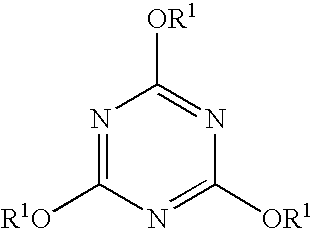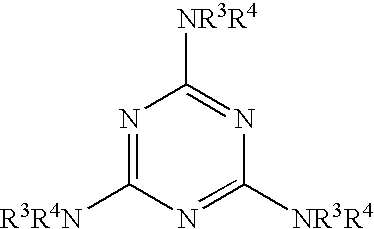Chemical markers
a technology of chemical markers and corresponding signals, applied in the field of chemical markers, can solve problems such as inability to use normal us
- Summary
- Abstract
- Description
- Claims
- Application Information
AI Technical Summary
Problems solved by technology
Method used
Image
Examples
example 1
Marking of Commercial Gasoline
[0027]To a sample vial was added 219 mg of triallyl-1,3,5-triazine-2,4,6(1H,3H,5H)-trione and 25 mL of reagent grade toluene. The mixture was agitated until a homogeneous solution was obtained. This stock solution contained 8,694 mg / L of the marker. A sub-sample of this stock solution was diluted with sufficient commercial gasoline to obtain a gasoline sample that contained 10.3 mg / L. This material was subjected to analysis using gas chromatography in conjunction with a mass spectrometer. This marker displayed strong characteristic signals at m / e of 249, 125, and 83. Using the chromatographic conditions mentioned below, and a mass spectrometer using selective Ion Detection Mode (SIM) and electron impact ionization (E.I.) this marker is detected with a retention time of 11.19 minutes. The column was an SPB-1 capillary column 30 m in length, 0.32 mm inside diameter, 0.25 μm film thickness. The temperature was 100° C. for 3 minutes, ramped at 10° C. / min to...
example 2
Marking of Commercial Diesel Fuel Oil
[0028]To a 100 mL volumetric flask was added 229 mg of 2,4,6-triphenoxy-1,3,5-triazine and 20 mL of reagent grade DMSO, and then the contents were diluted to a total volume of 100 mL with reagent grade toluene. The mixture was agitated until a homogeneous solution was obtained. This stock solution contained 2,290 mg / L of the marker. A sub-sample of this stock solution was diluted with sufficient commercial diesel to obtain a sample that contained 6.7 mg / L. This material was subjected to analysis using gas chromatography in conjunction with a mass spectrometer. This marker displayed strong characteristic signals at m / e of 264, 238, 145 and 121. Using the chromatographic conditions described in Example 1, this marker was detected with a retention time of 21.57 minutes. Further dilution of the diesel sample to a marker concentration of 0.63 mg / L was carried out. Analysis of this sample as described above revealed the presence of the marker.
example 3
Marking of Commercial Gasoline
[0029]To a sample of commercial gasoline was added sufficient triphenylamine such that the concentration of the marker was 10.3 mg / L. Further dilution with additional gasoline produced a series of samples ranging in concentration from 10.3 ppm down to 0.1 ppm (7.62-0.074 mg / L). These samples were subjected to analysis using gas chromatography in conjunction with a mass spectrometer. This marker displayed strong characteristic signals at m / e of 245, 244, 167, and 166. Using gas chromatography, and a mass spectrometer using selective Ion Detection Mode (SIM) and electron impact ionization (E.I.) this marker was detected in all samples and the response was found to be linear with a correlation coefficient (R2) value of 0.9988, and peak area=85660(c), where c is marker concentration in ppm.
PUM
| Property | Measurement | Unit |
|---|---|---|
| 1-octanol/water partition coefficient | aaaaa | aaaaa |
| 1-octanol/water partition coefficient | aaaaa | aaaaa |
| diameter | aaaaa | aaaaa |
Abstract
Description
Claims
Application Information
 Login to View More
Login to View More - R&D
- Intellectual Property
- Life Sciences
- Materials
- Tech Scout
- Unparalleled Data Quality
- Higher Quality Content
- 60% Fewer Hallucinations
Browse by: Latest US Patents, China's latest patents, Technical Efficacy Thesaurus, Application Domain, Technology Topic, Popular Technical Reports.
© 2025 PatSnap. All rights reserved.Legal|Privacy policy|Modern Slavery Act Transparency Statement|Sitemap|About US| Contact US: help@patsnap.com



